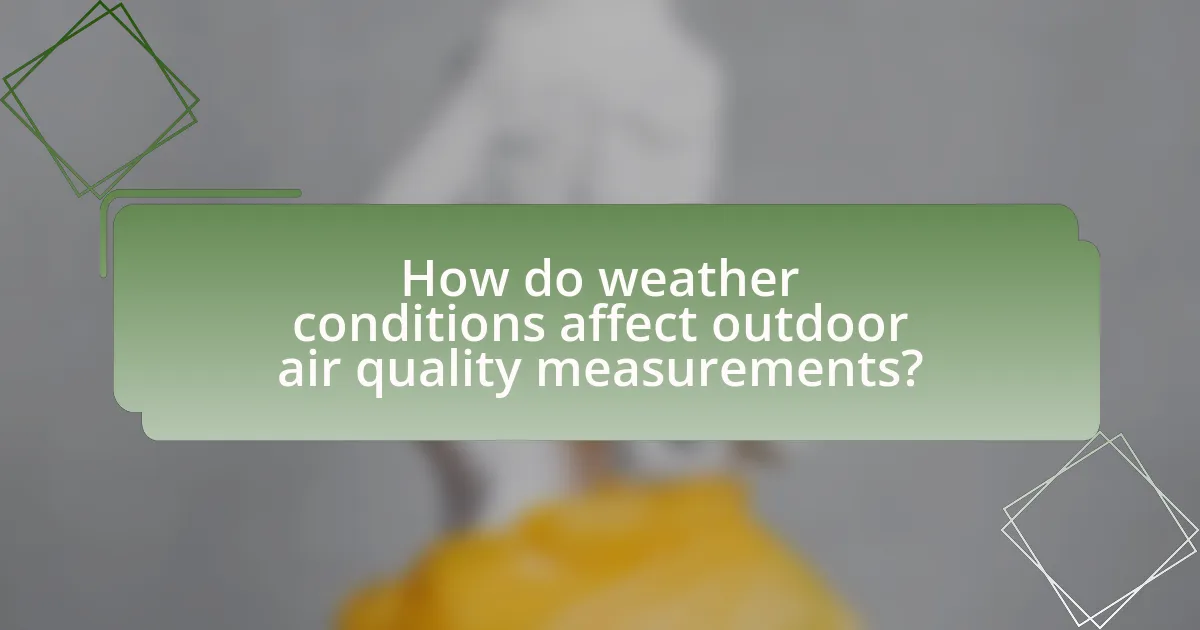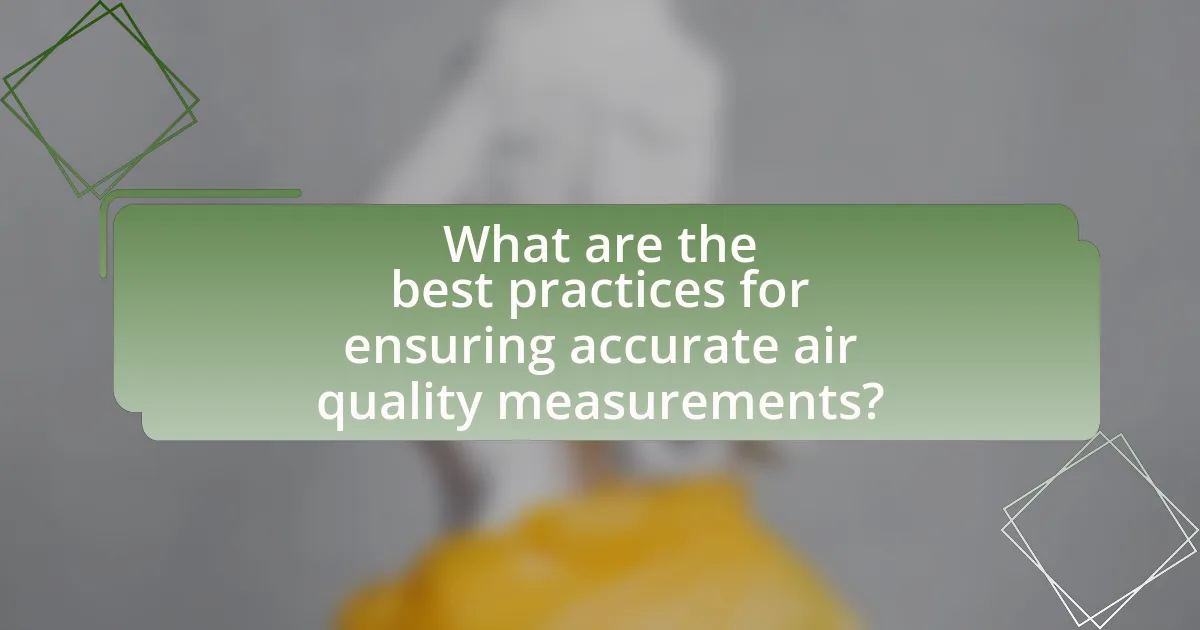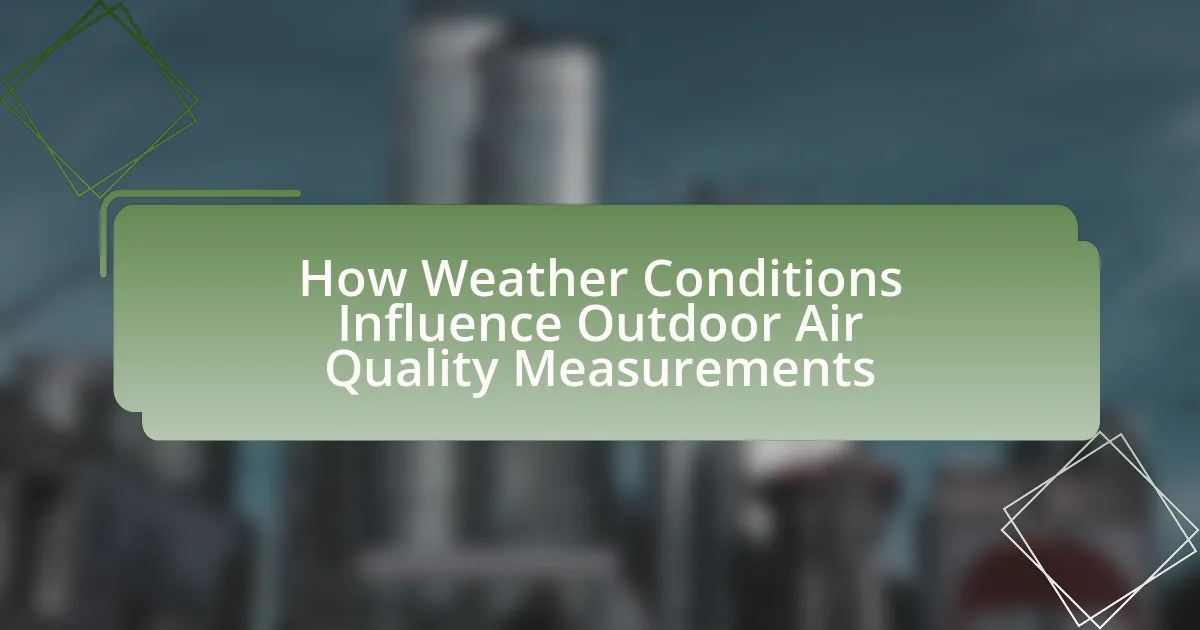Weather conditions play a crucial role in influencing outdoor air quality measurements by affecting pollutant dispersion, concentration, and chemical reactions. Key factors such as temperature, humidity, wind speed, and atmospheric pressure directly impact the levels of harmful substances in the air. For instance, temperature inversions can trap pollutants, while wind can disperse them, leading to significant variations in air quality indices. The article explores how these meteorological factors affect air quality readings, the methodologies used for accurate measurements, and the implications for public health and regulatory compliance. It emphasizes the importance of integrating weather data into air quality monitoring to ensure reliable assessments and effective public health interventions.
How do weather conditions affect outdoor air quality measurements?

Weather conditions significantly influence outdoor air quality measurements by affecting pollutant dispersion, concentration, and chemical reactions. For instance, temperature inversions can trap pollutants close to the ground, leading to higher concentrations of harmful substances, while wind can disperse these pollutants, resulting in lower concentrations. Additionally, humidity levels can impact the formation of secondary pollutants, such as ozone, as higher humidity can enhance chemical reactions that produce these pollutants. Studies have shown that variations in weather patterns, such as precipitation and temperature, can lead to fluctuations in air quality indices, demonstrating the direct relationship between meteorological factors and air quality measurements.
What specific weather factors influence air quality readings?
Specific weather factors that influence air quality readings include temperature, humidity, wind speed, and atmospheric pressure. Temperature affects the rate of chemical reactions in the atmosphere, with higher temperatures often leading to increased levels of ground-level ozone. Humidity can influence the formation of particulate matter and the dispersion of pollutants; higher humidity levels can lead to the condensation of pollutants into droplets, affecting visibility and air quality. Wind speed plays a crucial role in dispersing air pollutants; stronger winds can dilute concentrations of harmful substances, while calm conditions can lead to stagnation and higher pollutant levels. Atmospheric pressure impacts the vertical mixing of air; low pressure can trap pollutants near the surface, while high pressure can enhance dispersion. These factors collectively determine the concentration and distribution of air pollutants, as evidenced by studies linking weather patterns to variations in air quality indices.
How does temperature impact the concentration of pollutants?
Temperature significantly impacts the concentration of pollutants by influencing their chemical reactions and physical behaviors in the atmosphere. Higher temperatures can increase the rate of photochemical reactions, leading to elevated levels of ground-level ozone and other secondary pollutants. For instance, studies have shown that a 1°C increase in temperature can lead to a 3-5% increase in ozone concentration due to enhanced reaction rates among precursor chemicals like volatile organic compounds and nitrogen oxides. Additionally, warmer temperatures can reduce the solubility of certain pollutants in water bodies, resulting in higher concentrations in the air.
What role does humidity play in air quality measurements?
Humidity significantly affects air quality measurements by influencing the concentration and behavior of pollutants in the atmosphere. High humidity can lead to the formation of secondary pollutants, such as ozone and particulate matter, as moisture interacts with various chemicals in the air. For instance, studies have shown that increased humidity levels can enhance the formation of fine particulate matter (PM2.5) through chemical reactions involving precursor gases. Additionally, humidity can impact the performance of air quality sensors, as many devices are calibrated under specific humidity conditions, potentially leading to inaccurate readings if those conditions change.
How do wind patterns affect the dispersion of air pollutants?
Wind patterns significantly influence the dispersion of air pollutants by determining their movement and concentration in the atmosphere. Strong winds can dilute and disperse pollutants over a larger area, reducing their concentration at ground level, while calm winds can lead to the accumulation of pollutants in specific locations, increasing exposure risks. For instance, studies have shown that urban areas with consistent wind patterns can experience lower levels of air pollution due to effective dispersion, whereas stagnant air conditions can trap pollutants, leading to higher concentrations and potential health hazards.
Why is it important to consider weather conditions in air quality monitoring?
Considering weather conditions in air quality monitoring is crucial because they significantly affect pollutant dispersion and concentration levels. Weather factors such as temperature, humidity, wind speed, and atmospheric pressure influence how pollutants are transported and transformed in the atmosphere. For instance, higher temperatures can increase the formation of ground-level ozone, while wind can disperse or concentrate pollutants in specific areas. Studies have shown that air quality measurements can vary dramatically based on these conditions; for example, the U.S. Environmental Protection Agency (EPA) emphasizes that accurate air quality assessments must account for meteorological data to ensure reliable public health advisories.
How can inaccurate measurements lead to public health risks?
Inaccurate measurements can lead to public health risks by misrepresenting the levels of pollutants in the air, which can result in inadequate responses to air quality issues. For instance, if air quality monitoring systems fail to account for weather conditions such as temperature and humidity, they may report lower levels of harmful substances like particulate matter or ozone than actually present. This misrepresentation can lead to insufficient public health advisories, causing vulnerable populations, such as those with respiratory conditions, to be exposed to unsafe air quality. Studies have shown that accurate air quality measurements are crucial for effective public health interventions; for example, the World Health Organization emphasizes that reliable data is essential for protecting community health and guiding policy decisions.
What are the implications for regulatory compliance?
The implications for regulatory compliance regarding outdoor air quality measurements influenced by weather conditions include the necessity for accurate data collection methods that account for environmental variables. Regulatory bodies require that air quality data be reliable and representative, which means that fluctuations in temperature, humidity, and wind can affect the validity of measurements. For instance, the U.S. Environmental Protection Agency (EPA) mandates that monitoring equipment must be calibrated and maintained to ensure compliance with the National Ambient Air Quality Standards (NAAQS). Failure to consider weather impacts can lead to non-compliance, resulting in potential penalties and the need for corrective actions.
What methodologies are used to measure air quality under varying weather conditions?

Air quality is measured under varying weather conditions using methodologies such as passive sampling, active sampling, remote sensing, and sensor networks. Passive sampling involves collecting air samples over time without the need for a power source, allowing for the assessment of pollutants like nitrogen dioxide and ozone under different weather scenarios. Active sampling, on the other hand, utilizes pumps to draw air through filters or sorbents, providing real-time data on particulate matter and gaseous pollutants, which can vary significantly with weather changes.
Remote sensing employs satellite or aerial imagery to monitor air quality indicators over large areas, capturing data influenced by meteorological factors such as temperature and humidity. Sensor networks consist of multiple low-cost sensors distributed across a region, enabling localized air quality monitoring that accounts for variations in weather conditions. These methodologies are validated by studies demonstrating their effectiveness in capturing the dynamic relationship between air quality and weather, such as the research published in the journal “Environmental Science & Technology” by authors including Zhang et al., which highlights the impact of meteorological variables on pollutant dispersion and concentration.
How do different measurement techniques account for weather variability?
Different measurement techniques account for weather variability by incorporating real-time data and adjustments based on meteorological conditions. For instance, methods such as passive sampling and active sampling can be calibrated to account for temperature fluctuations, humidity levels, and wind speed, which directly influence pollutant dispersion and concentration. Studies have shown that integrating meteorological data into air quality models enhances the accuracy of measurements; for example, the use of meteorological sensors alongside air quality monitors allows for dynamic adjustments that reflect changing weather patterns, thereby improving the reliability of the data collected.
What are the advantages of using real-time monitoring systems?
Real-time monitoring systems provide immediate data collection and analysis, allowing for timely decision-making regarding air quality. These systems enable continuous tracking of environmental conditions, which is crucial for understanding how weather influences outdoor air quality measurements. For instance, real-time data can reveal the impact of temperature, humidity, and wind patterns on pollutant levels, facilitating prompt responses to deteriorating air quality. Studies have shown that real-time monitoring can improve public health outcomes by providing alerts during pollution spikes, thereby enhancing community awareness and safety.
How do laboratory analyses differ from field measurements in this context?
Laboratory analyses differ from field measurements in that laboratory analyses provide controlled, precise, and repeatable conditions for testing air quality samples, while field measurements capture real-time data influenced by varying weather conditions. Laboratory analyses allow for the isolation of specific pollutants and the use of standardized methods, ensuring accuracy and reliability, as demonstrated by studies that show laboratory results can be more consistent than field data due to the elimination of environmental variables. In contrast, field measurements reflect the actual atmospheric conditions, including temperature, humidity, and wind, which can significantly affect pollutant concentrations and dispersion, as evidenced by research indicating that outdoor air quality can fluctuate dramatically based on immediate weather patterns.
What technologies enhance the accuracy of air quality measurements?
Technologies that enhance the accuracy of air quality measurements include low-cost sensors, satellite remote sensing, and advanced data analytics. Low-cost sensors provide real-time data and can be deployed in dense networks, improving spatial resolution. Satellite remote sensing offers comprehensive coverage and can monitor large areas, capturing data on pollutants from above. Advanced data analytics, including machine learning algorithms, process and interpret complex datasets, allowing for more precise predictions and insights into air quality trends. These technologies collectively improve measurement accuracy by providing diverse data sources and enhancing analytical capabilities.
How do satellite observations contribute to understanding air quality?
Satellite observations significantly enhance the understanding of air quality by providing comprehensive, real-time data on atmospheric pollutants across large geographic areas. These observations utilize remote sensing technology to measure concentrations of gases such as nitrogen dioxide, ozone, and particulate matter, which are critical indicators of air quality. For instance, NASA’s Aura satellite employs advanced instruments to monitor air pollution levels globally, enabling researchers to analyze trends and identify pollution sources. This data is essential for validating ground-based measurements and improving air quality models, ultimately aiding in public health assessments and policy-making.
What role do mobile monitoring units play in data collection?
Mobile monitoring units play a crucial role in data collection by providing real-time measurements of air quality across various locations. These units are equipped with advanced sensors that capture data on pollutants, temperature, humidity, and other environmental factors, allowing for a comprehensive understanding of how weather conditions affect outdoor air quality. For instance, studies have shown that mobile monitoring can reveal spatial variations in air quality that stationary monitoring stations may miss, thus enhancing the accuracy of environmental assessments.
What are the best practices for ensuring accurate air quality measurements?

The best practices for ensuring accurate air quality measurements include regular calibration of monitoring equipment, selecting appropriate measurement locations, and using standardized methodologies. Regular calibration ensures that instruments provide precise readings, as drift can occur over time. Selecting measurement locations away from direct pollution sources and representative of the area being studied enhances data reliability. Utilizing standardized methodologies, such as those outlined by the Environmental Protection Agency, ensures consistency and comparability across different studies. These practices are supported by research indicating that accurate calibration and proper site selection significantly reduce measurement errors, thereby improving the validity of air quality assessments.
How can monitoring stations be optimized for weather conditions?
Monitoring stations can be optimized for weather conditions by implementing adaptive calibration techniques that account for environmental variables. These techniques involve regularly adjusting sensor readings based on real-time weather data, such as temperature, humidity, and wind speed, which can significantly affect air quality measurements. Research indicates that incorporating machine learning algorithms to analyze historical weather patterns and their impact on sensor accuracy can enhance the reliability of data collected by monitoring stations. For instance, a study published in the journal “Environmental Science & Technology” demonstrated that stations utilizing adaptive calibration showed a 20% improvement in measurement accuracy during varying weather conditions compared to static calibration methods.
What strategies can be employed to calibrate instruments effectively?
To calibrate instruments effectively, one can employ strategies such as regular maintenance, using standardized reference materials, and conducting field calibrations under varying environmental conditions. Regular maintenance ensures that instruments function correctly and reduces drift over time, while standardized reference materials provide a consistent baseline for comparison, enhancing accuracy. Field calibrations account for the influence of weather conditions, such as temperature and humidity, which can affect instrument performance. These strategies are supported by studies indicating that systematic calibration practices improve measurement reliability and accuracy in outdoor air quality assessments.
How often should maintenance be performed on air quality monitoring equipment?
Maintenance on air quality monitoring equipment should be performed at least once every six months. Regular maintenance ensures the accuracy and reliability of the measurements, as environmental factors can affect the performance of the equipment. According to the U.S. Environmental Protection Agency, routine checks and calibrations are essential to maintain the integrity of air quality data, which can be influenced by weather conditions such as humidity and temperature fluctuations.
What tips can help improve the reliability of outdoor air quality data?
To improve the reliability of outdoor air quality data, it is essential to ensure proper calibration of monitoring equipment. Regular calibration minimizes measurement errors and enhances data accuracy, as studies show that uncalibrated sensors can yield results that deviate significantly from actual air quality levels. Additionally, deploying sensors in representative locations, away from local pollution sources, can provide a more accurate reflection of regional air quality. Research indicates that environmental factors, such as temperature and humidity, can affect sensor performance; thus, using temperature-compensated sensors can further enhance data reliability. Finally, implementing data validation techniques, such as cross-referencing with established monitoring stations, can help identify anomalies and improve overall data quality.
How can data interpretation be adjusted based on weather patterns?
Data interpretation can be adjusted based on weather patterns by incorporating real-time meteorological data to contextualize air quality measurements. For instance, temperature, humidity, and wind speed significantly influence pollutant dispersion and concentration levels. Studies have shown that higher temperatures can increase the formation of ground-level ozone, while humidity can affect particulate matter levels. By analyzing these weather variables alongside air quality data, researchers can better understand the relationship between environmental conditions and pollutant behavior, leading to more accurate assessments and predictions of air quality.
What common pitfalls should be avoided in air quality measurement?
Common pitfalls to avoid in air quality measurement include improper calibration of instruments, neglecting environmental factors, and using inadequate sampling methods. Improper calibration can lead to inaccurate readings, as instruments must be regularly adjusted to ensure precision. Neglecting environmental factors, such as temperature and humidity, can skew results since these conditions significantly affect pollutant concentrations. Additionally, using inadequate sampling methods, like short sampling durations or non-representative locations, can result in data that does not accurately reflect overall air quality. These pitfalls can compromise the reliability of air quality assessments and lead to misguided conclusions.

Leave a Reply